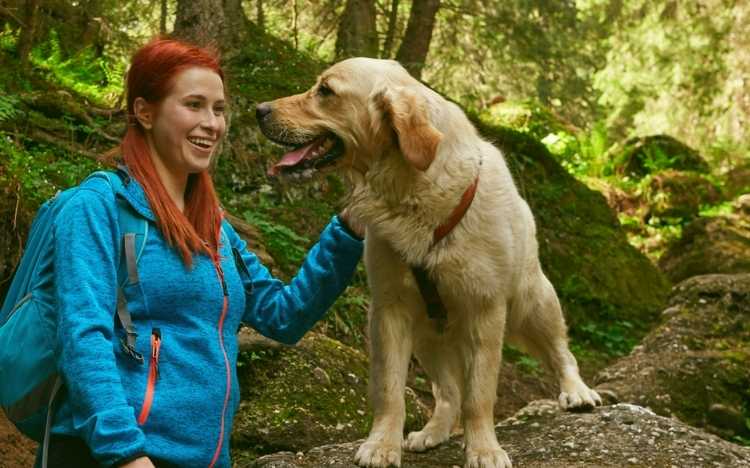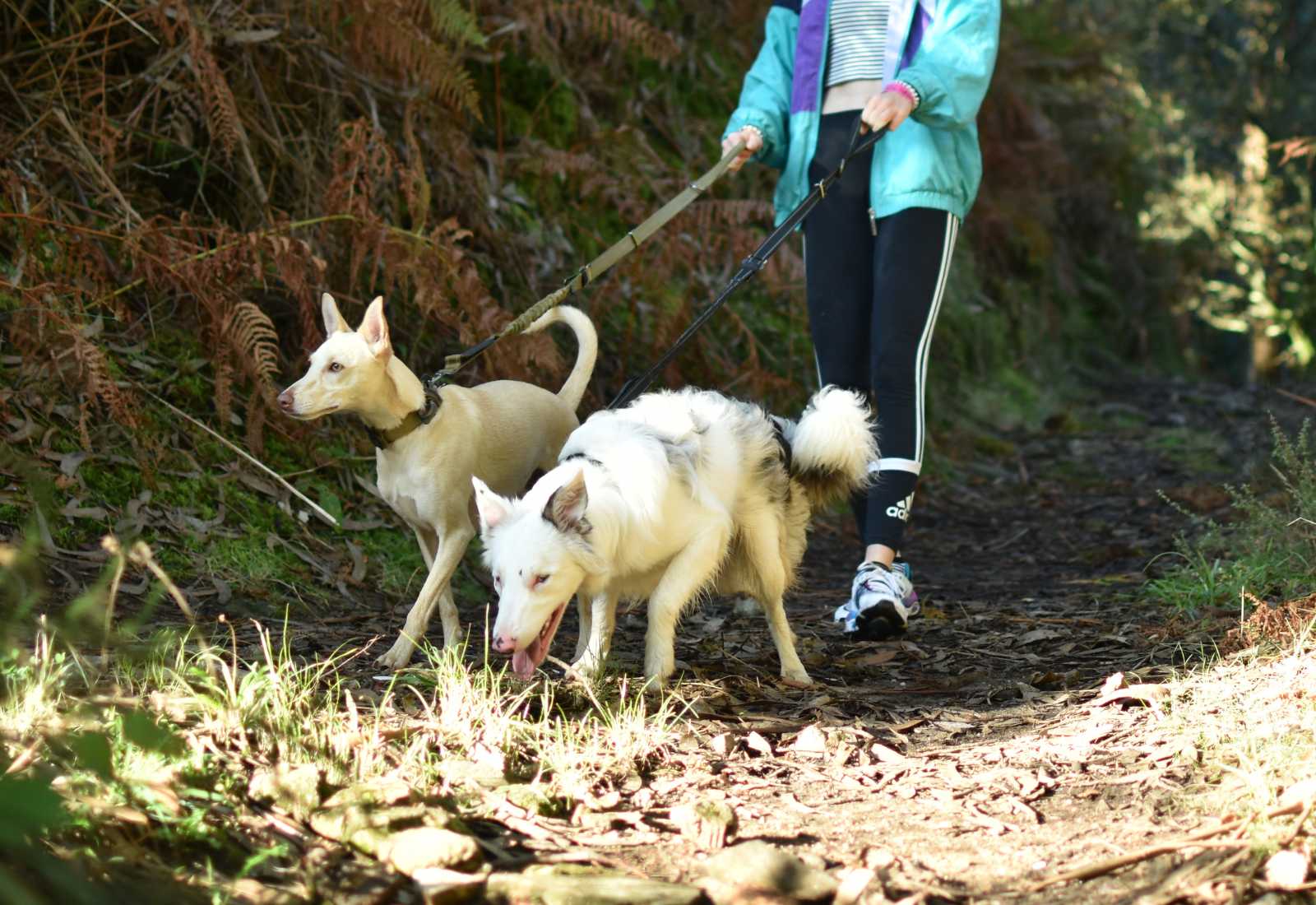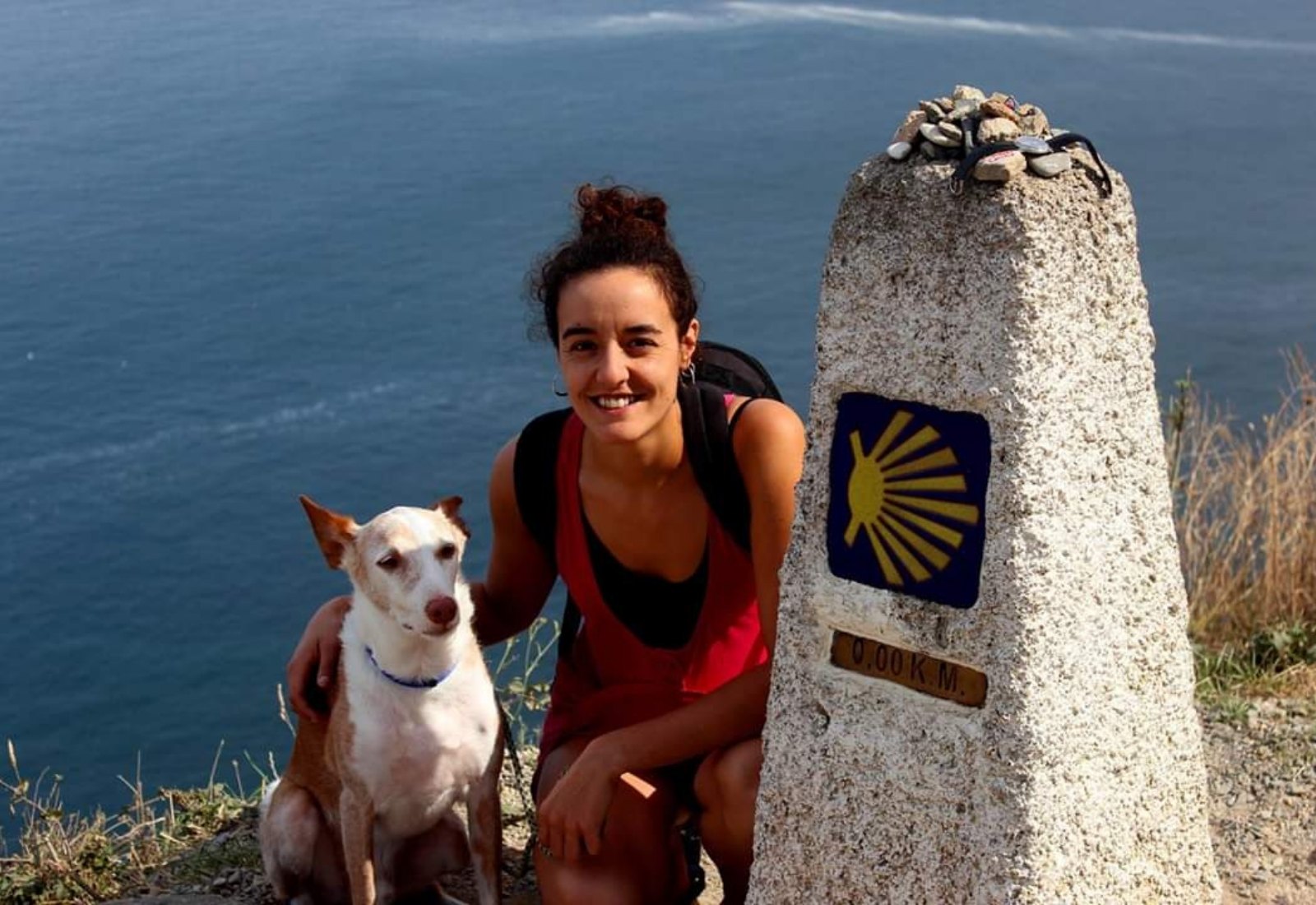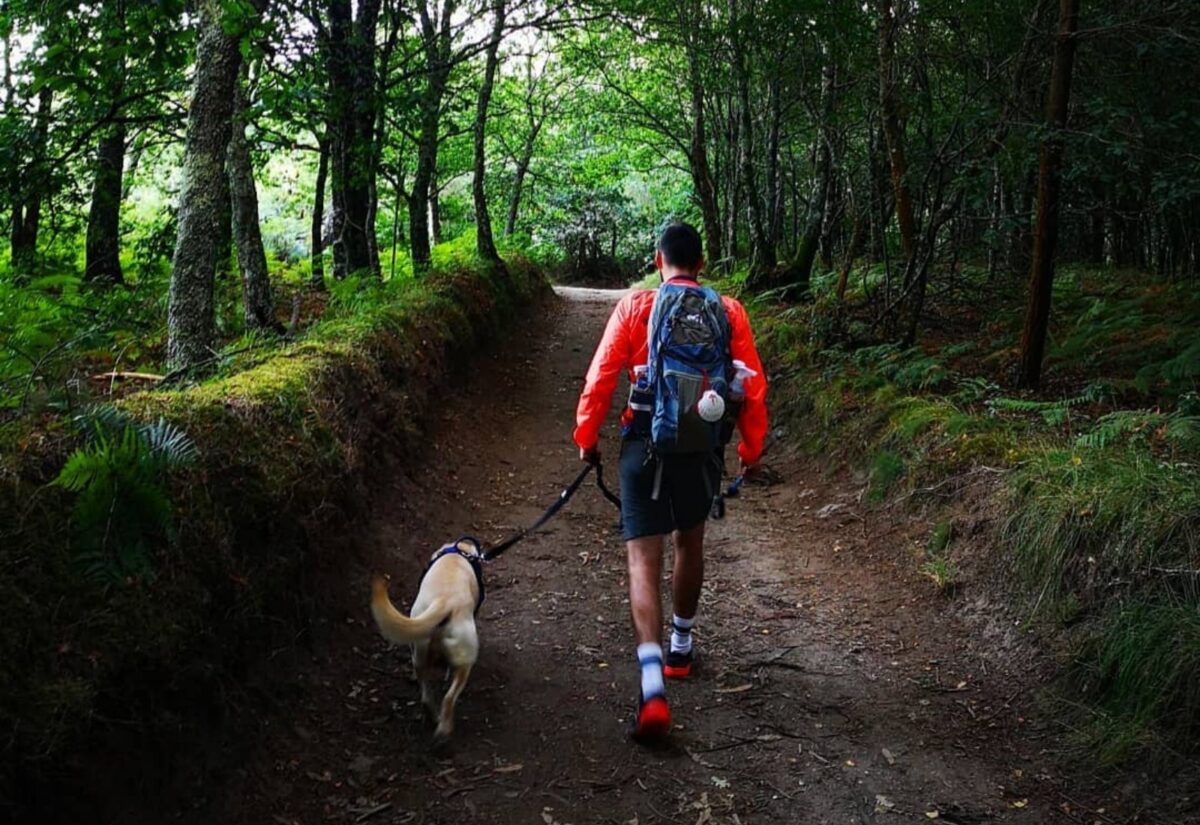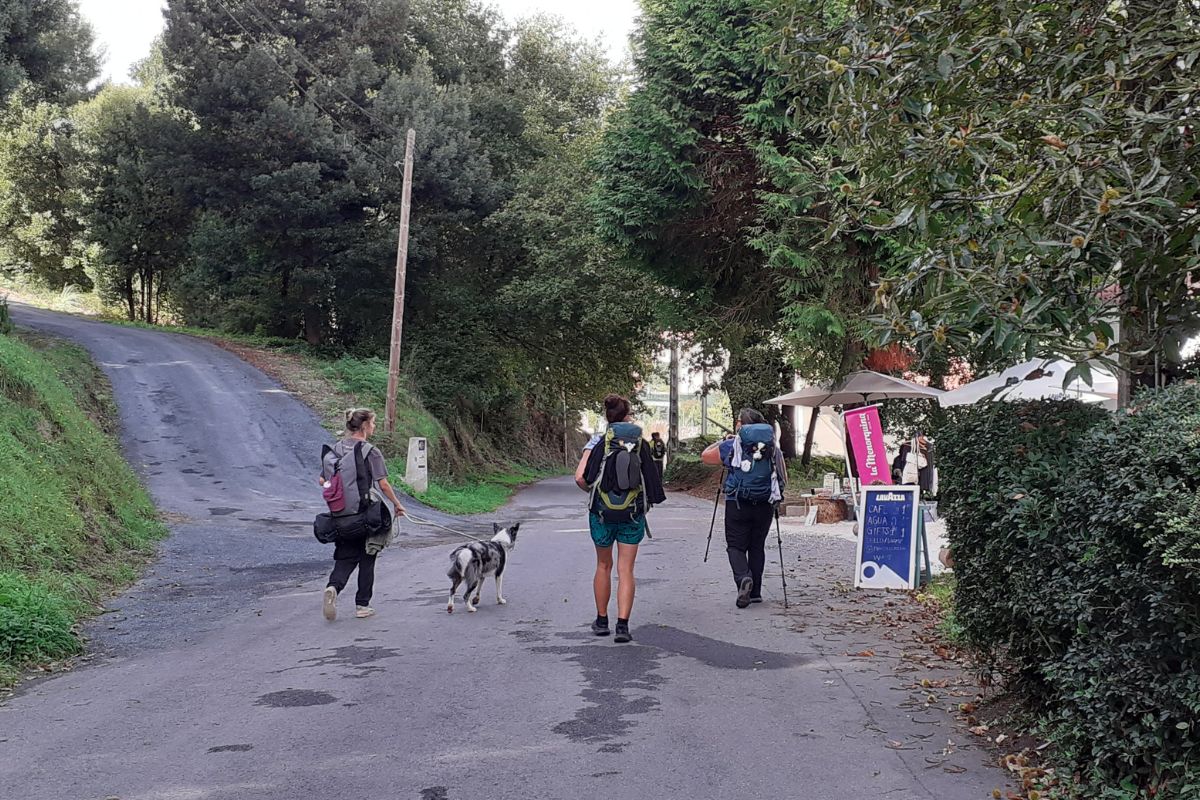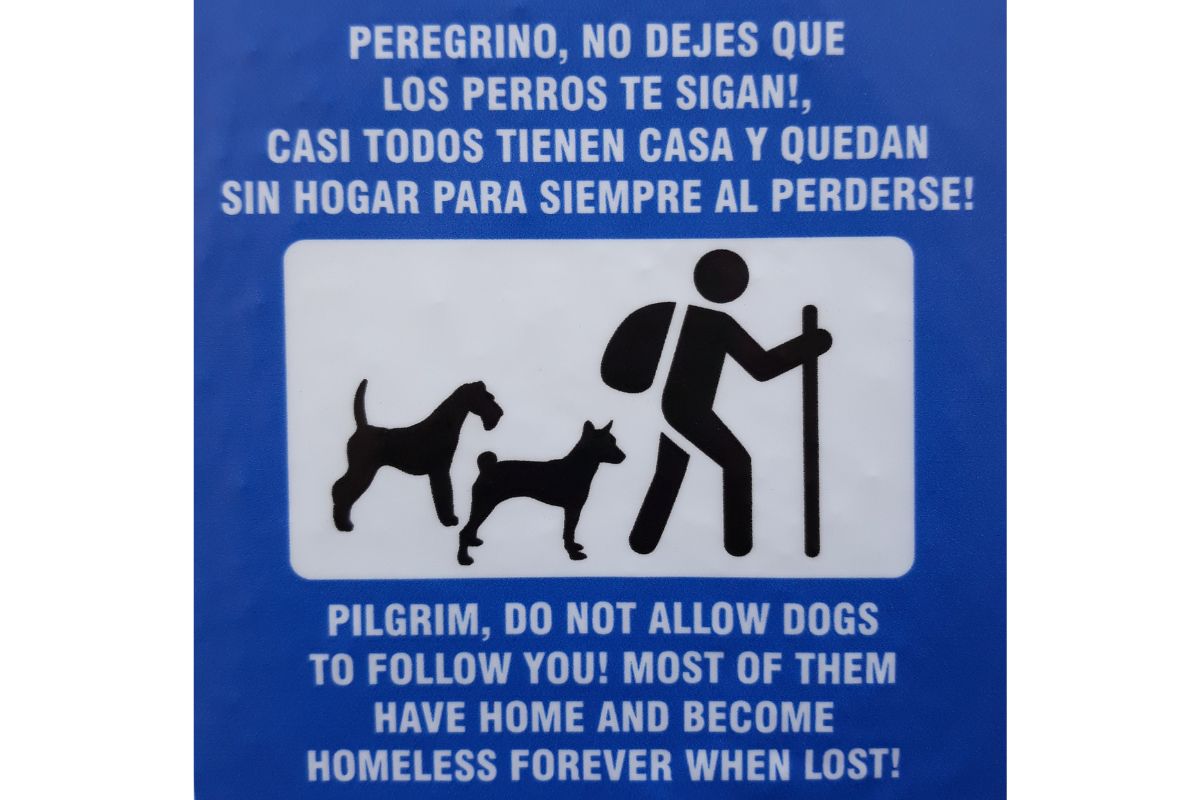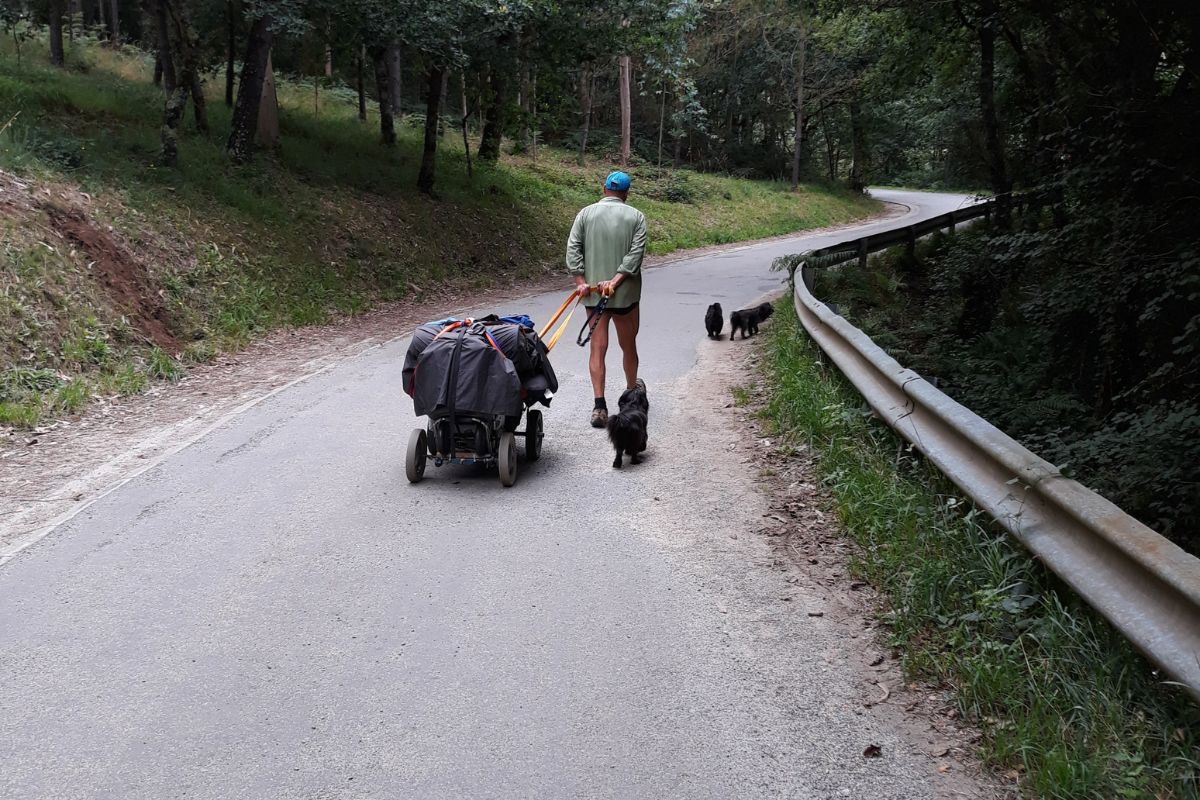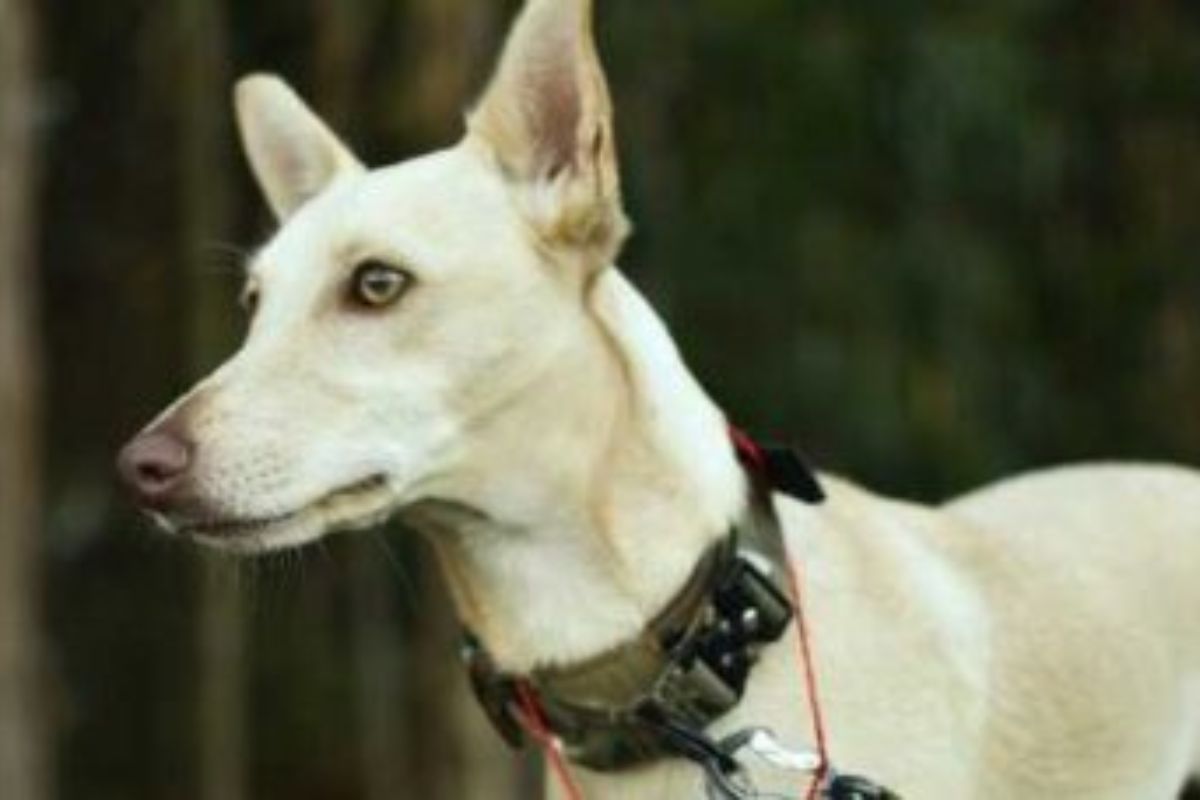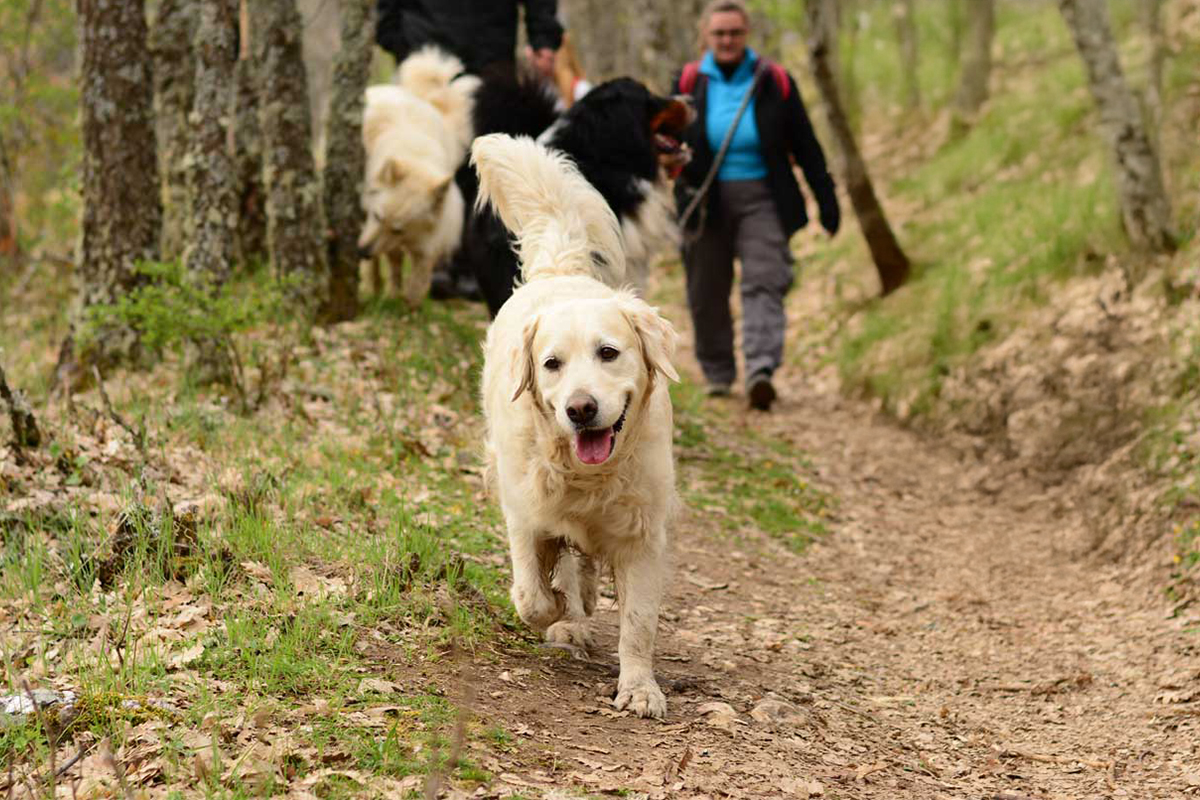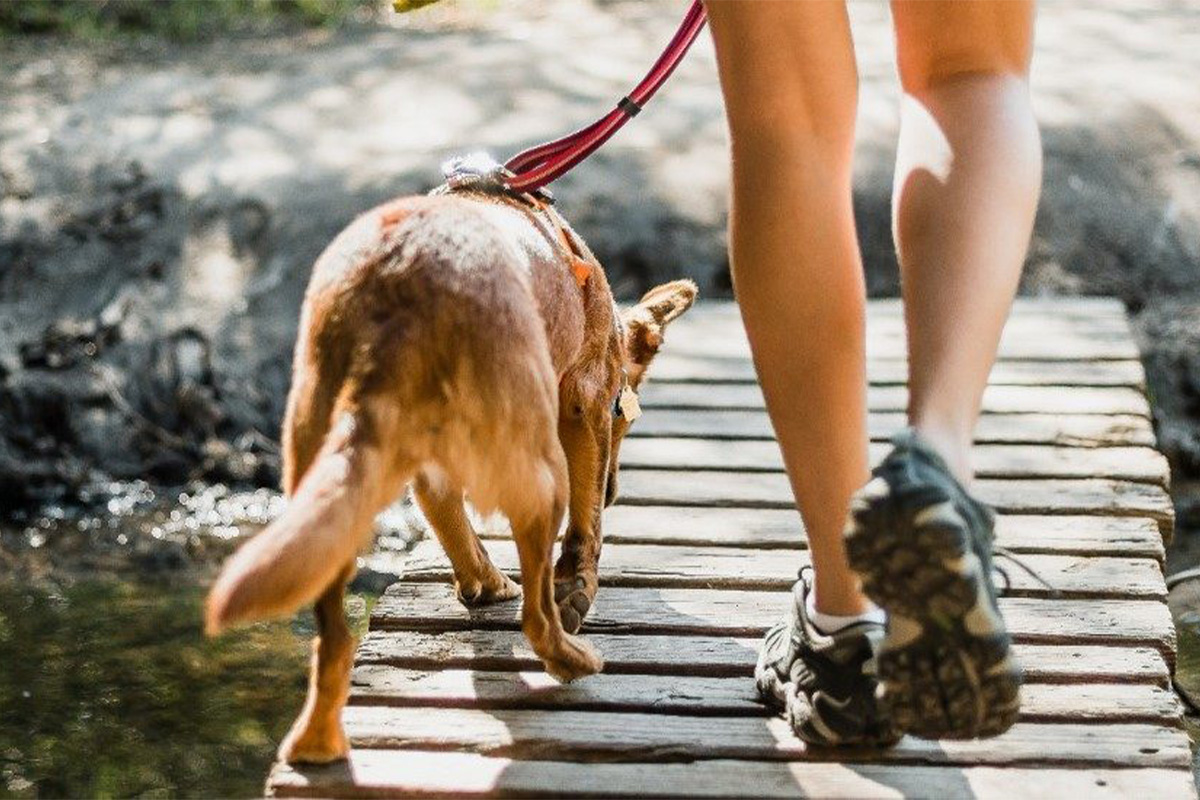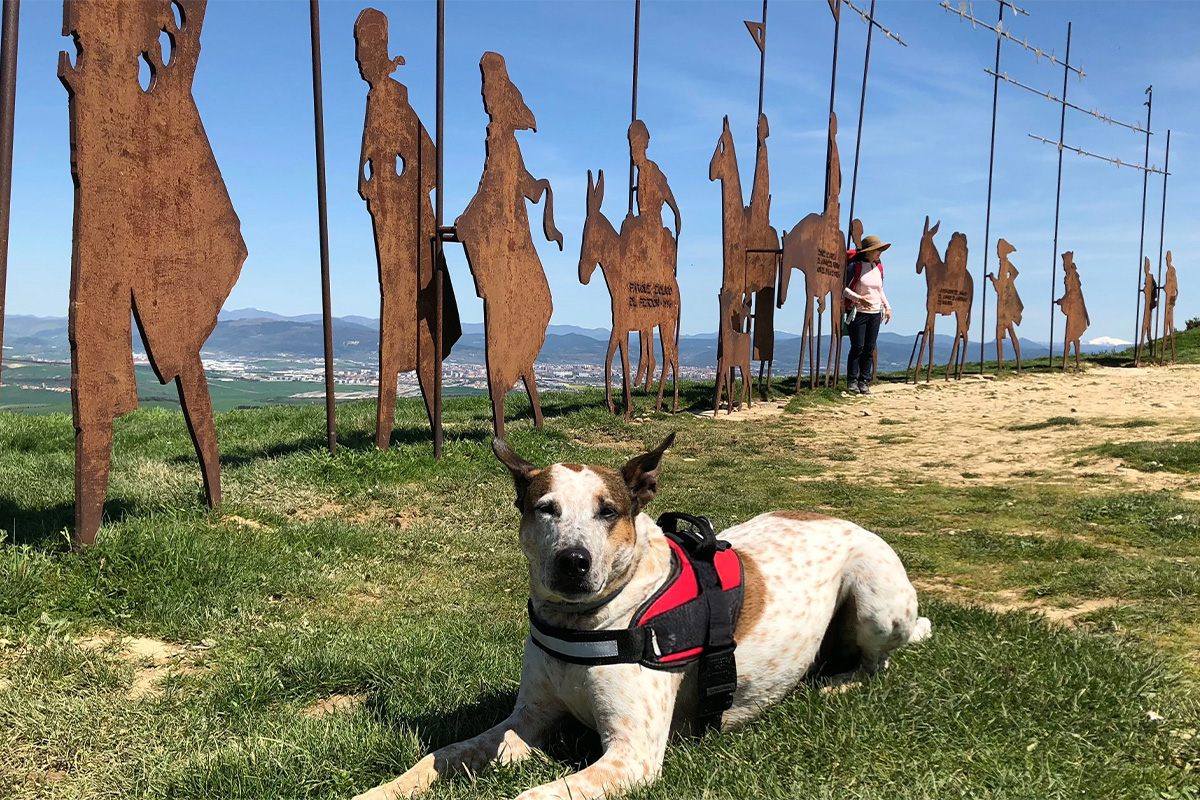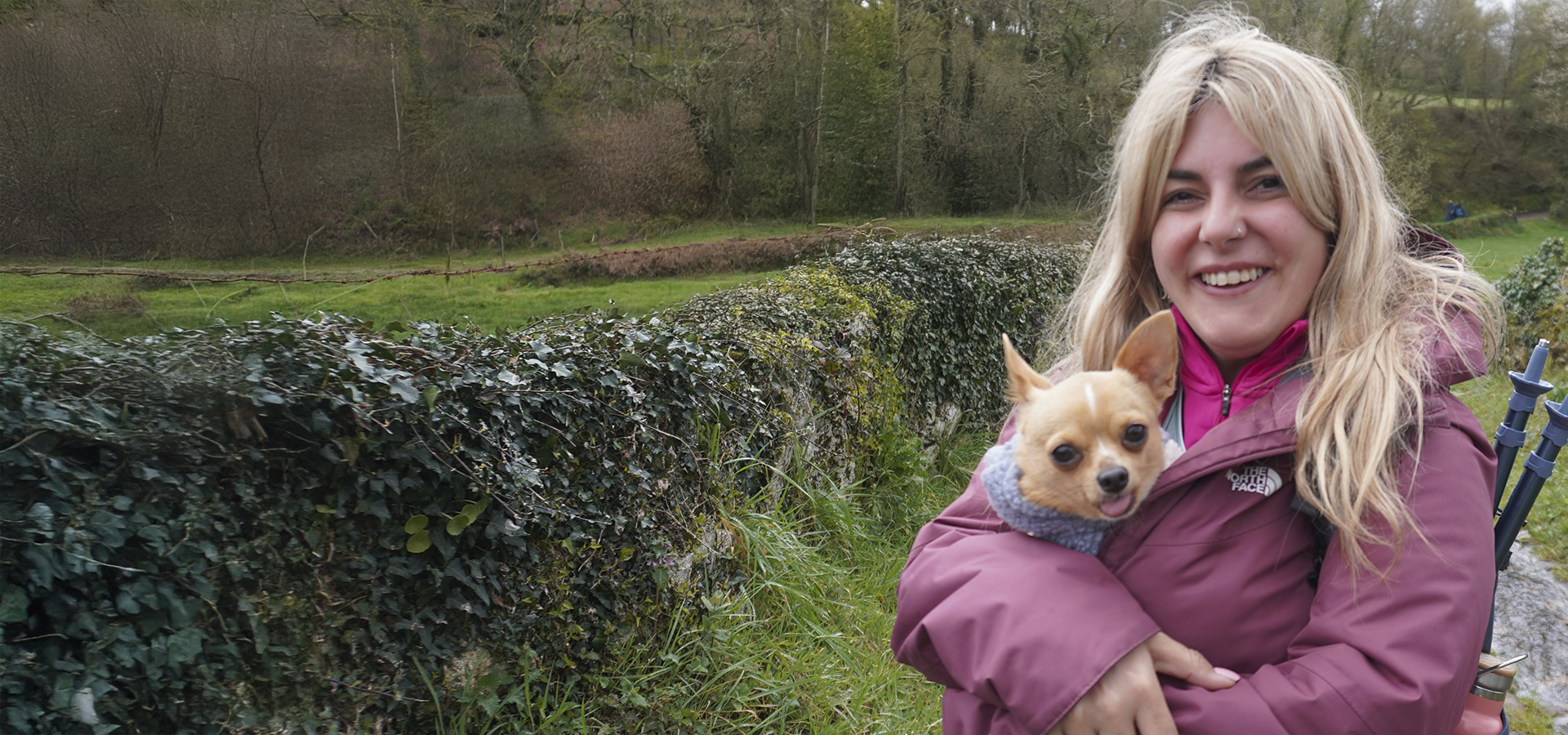Camino de Santiago with your dog
In 5 or 6 stages, walking with your pet
Walk the Camino with your dog and the highest-rated agency
Camino de Santiago > Travel Packages > With your Dog
Can you imagine enjoying the Camino de Santiago with your dog? Now it’s possible to walk the last 100 kilometers of the French Way from Sarria, the Portuguese Way from Tui, or the Portuguese Way by the Coast from Vigo, staying in dog-friendly accommodations, designed for both you and your pet to have an unforgettable experience. From Sarria, Tui, or Vigo, you’ll encounter unique landscapes, charming villages, and a route designed for you to enjoy every step alongside your dog. Because your furry friend can be a “dog-grim” too!
Choose from our most popular routes to do the Camino de Santiago with your dog.
At Viajes Camino de Santiago, we know that organizing the Camino with your pet can be a complicated task. No worries, with our Camino de Santiago with a Dog, we’ll make it easy for you.
On our trips, we offer the best dog-friendly accommodations along the Camino de Santiago, which are not many. That’s why we work with a limited number of pilgrims accompanied by their pets, ensuring personalized attention and a tailor-made itinerary.
Our goal is to understand your needs, your dog’s needs, and any detail that will make this trip a unique experience for both of you. We design an exclusive adventure for you and your best friend. Spend a week with 5 or 6 days walking the last 100 km, and you’ll enjoy a unique experience together on the Camino de Santiago.
Ready to take the first step? Your Camino starts here!
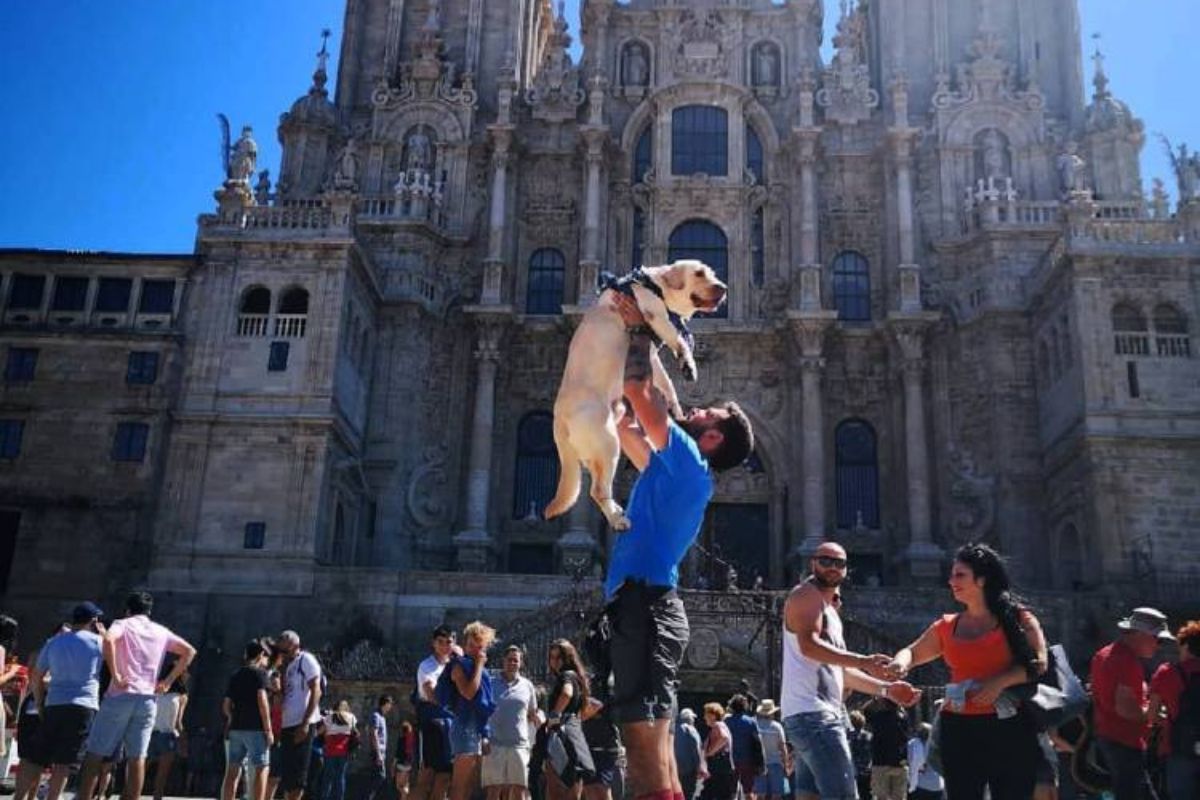
What is the best Camino de Santiago to do with a dog?
We have it clear: the French Way from Sarria, the Portuguese Way from Tui, or the Portuguese Way by the Coast from Vigo are the best routes you can take with your dog.
- These are the final sections and they lead you to Santiago de Compostela.
- With 115 km to Santiago de Compostela, they allow you to earn the Compostela and the “Perregrina” or canine Compostela, certificates for completing the pilgrimage.
- They are well signposted.
- These are very safe routes.
- They offer the full essence of Galicia, with its landscapes, people, cuisine, and heritage.
- They make your pilgrimage easier thanks to the many services available along the route.
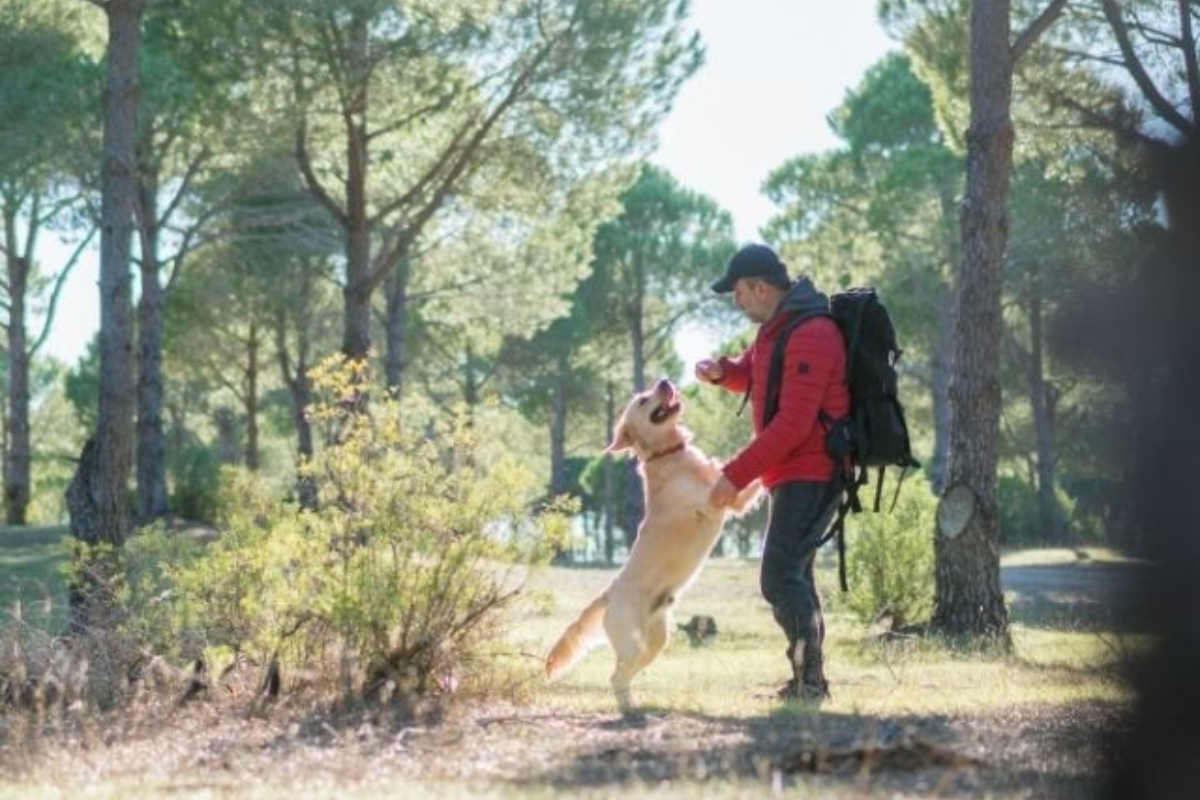
How to do the Camino de Santiago with your dog
The Camino de Santiago and its last 100 km from Sarria, Tui, or Vigo is a distance that most pilgrims complete in 5 or 6 stages, with daily stretches averaging between 20 and 25 km.
Choose the date to start your adventure and decide the number of stages according to your pace. It’s advisable to start some physical preparation, with short walks to get both of you accustomed to long distances. The route is accessible for anyone and their furry companion, thanks to a gentle terrain profile, though it will require some effort that will be well rewarded upon reaching Santiago.
Along the Camino, you’ll enjoy wonderful landscapes and services throughout the route. You can stop at charming spots under the shade of trees, let your dog cool off in the streams that cross the path, or rest together on the terraces of the numerous bars you’ll find. The Camino de Santiago thus becomes an unforgettable experience for both you and your loyal four-legged friend.
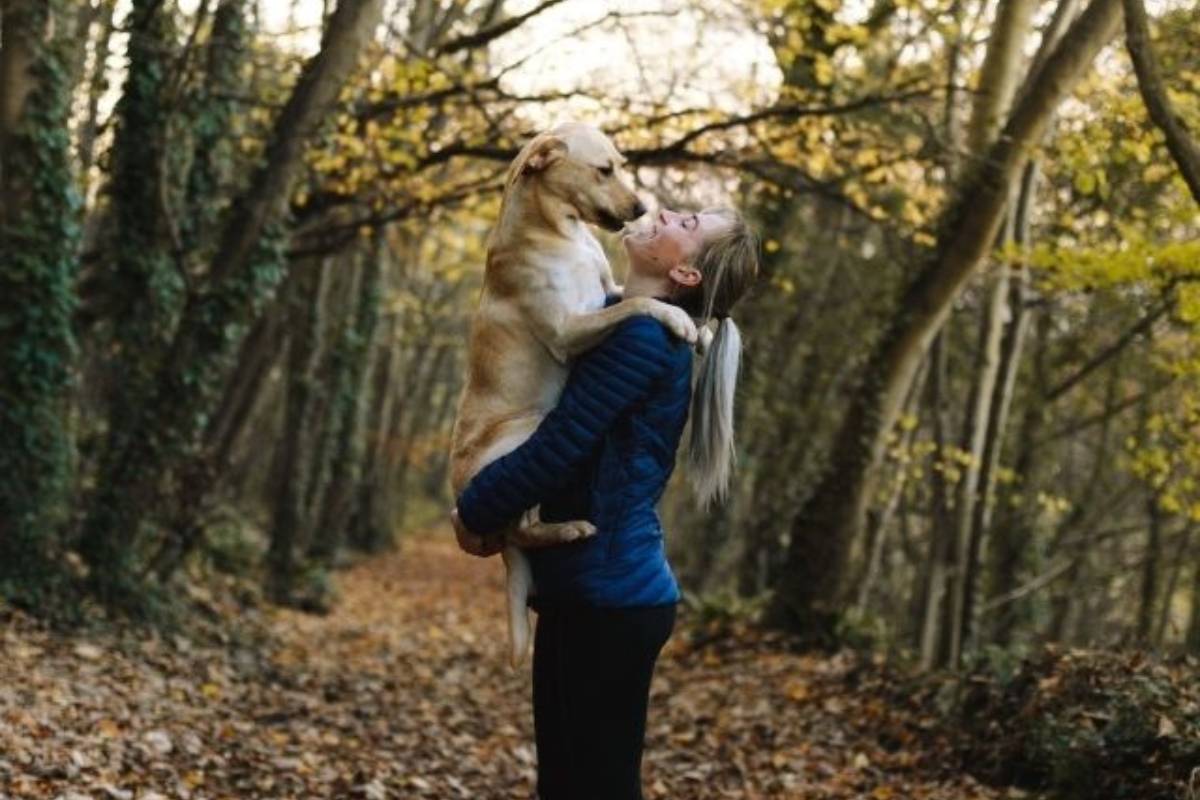
What to bring to do the Camino with your dog?
You will need to bring your dog’s documentation:
- Vaccination record
- Microchip
- Health certificate
- Canine credential (we provide this for you)
Also, don’t forget your dog’s gear:
- Harness and leash
- Portable water bowl
- First aid kit
- Raincoat or blanket
- Quick-dry towel
- Portable bed
- Sleeping bag
📌 Remember: With our trips, your dog’s luggage transport is always included, just like yours. 🚶♂️🐕
Practical tips for doing the Camino de Santiago with a dog
- Consult your veterinarian: Make sure your dog is in good health and up to date with vaccinations.
- Prepare your pet: Before starting, take progressive walks to get them used to long distances.
- Take care of your pet: Ensure your dog stays well-hydrated, and pay attention to their paws.
- Respect the environment: Carry bags to pick up their waste and don’t let them off-leash all the time, as you’ll encounter more “perregrinos” and livestock on the trails.
- Remember, you can request your Compostela at the Pilgrim’s Office in Santiago, but to get the “Perregrina” or canine Compostela, you’ll need to do it here.
You may be interested in:
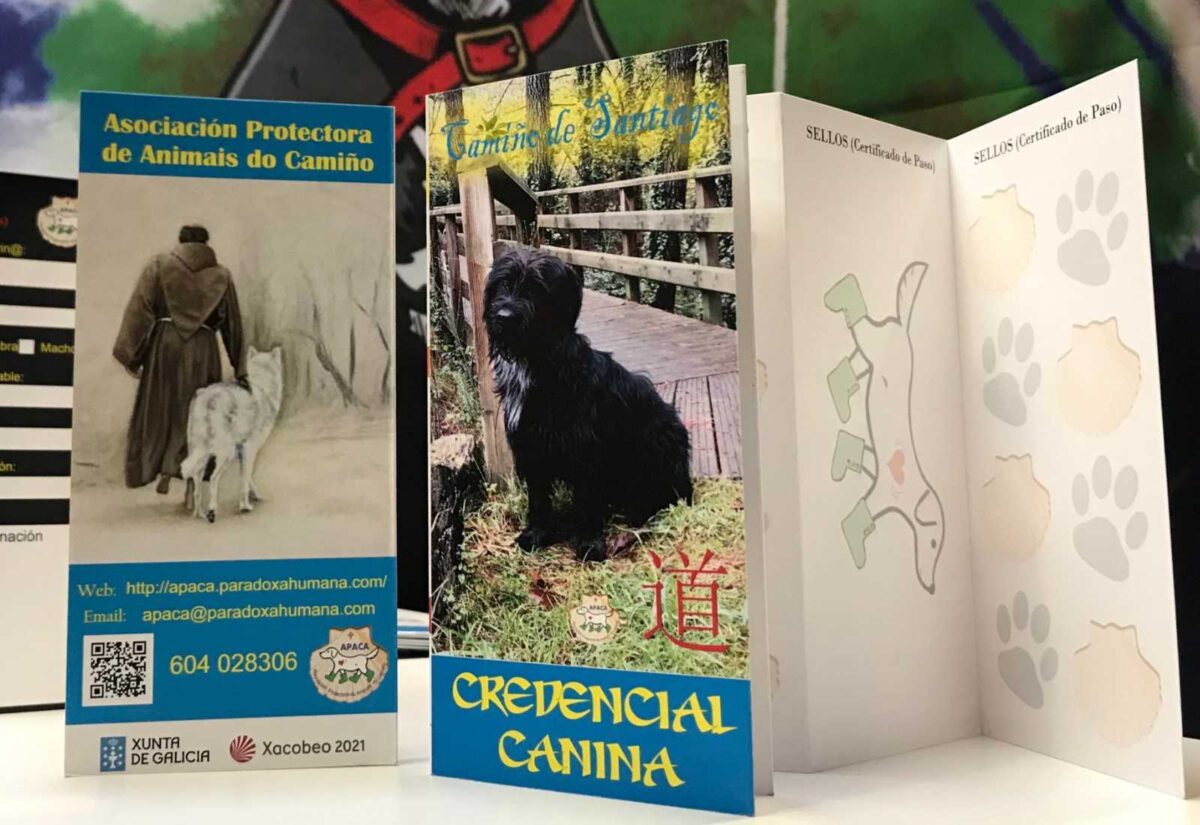
How to get to the start of your Camino de Santiago with your dog
We know that traveling with your dog on public transport can be a real challenge. From access restrictions on some trains and buses to size limits or the discomfort of long journeys, planning a trip with your pet can become quite a task.
But we have the perfect solution for you!
Private transfers and transfer of your own vehicle
At Viajes Camino de Santiago, we understand how important it is to start your Camino with peace of mind and enjoy every moment. That’s why we offer private and exclusive transfers where your dog will always be welcome.
With our personalized transfers, you can get to the starting point of your Camino de Santiago without worries, with all the comfort and space you need for you and your pet. We adapt to your schedule, pick you up at the airport or city in Galicia that you specify (Santiago de Compostela, Vigo, A Coruña, etc.), and ensure a comfortable journey for both of you.
Similarly, if you arrive at the start of your Camino with your own vehicle, which might be the best way to travel with your dog, we can provide an exclusive Own Vehicle Transfer service from Sarria, Tui, or Vigo to Santiago de Compostela. That way, when you finish your Camino and arrive in Santiago, your car will be waiting for you, safely stored. To learn more, visit our page on Own Vehicle Transfer.
You may be interested in:
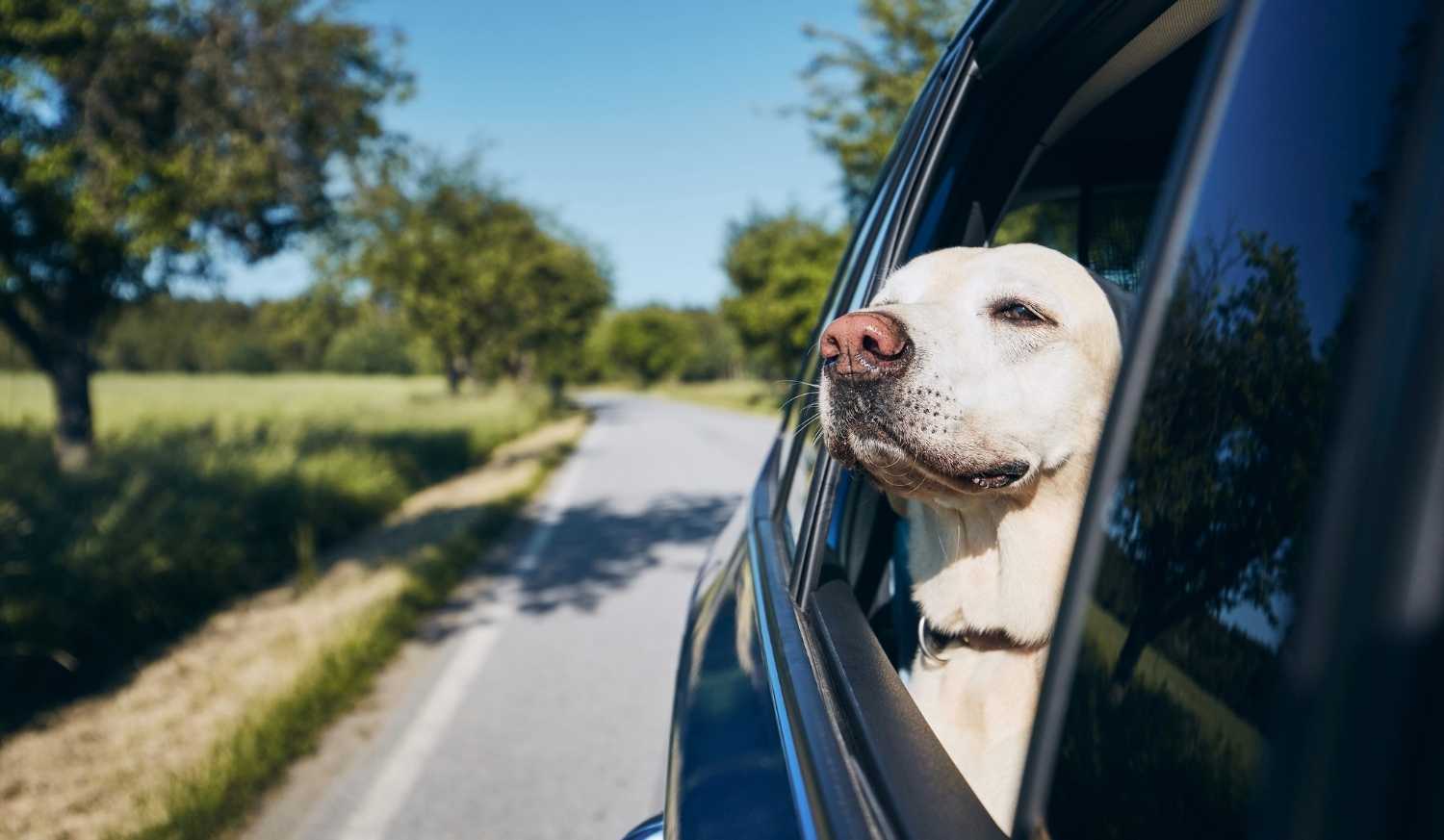
When to do the Camino de Santiago: pros and cons
The Camino de Santiago is, so to speak, open year-round, although the best time to do it is between spring and autumn. One must consider the weather conditions in winter, with its cold, rain, and even snow.
Therefore, the Camino de Santiago has its high and low seasons, and here are the advantages of each:
- High season: between March and October, where the spring and summer weather is very pleasant, although there may be some hot moments and occasional summer rain. These months attract the highest number of pilgrims, so during the high season, it’s easy to make many pilgrim friends.
- Low season: between November and February, where the cold and rainy autumn and winter weather results in fewer pilgrims, allowing for a more solitary experience. During this period, and due to the lower number of pilgrims, it’s easier to find accommodation without a prior reservation, although many also take this time to close for rest.
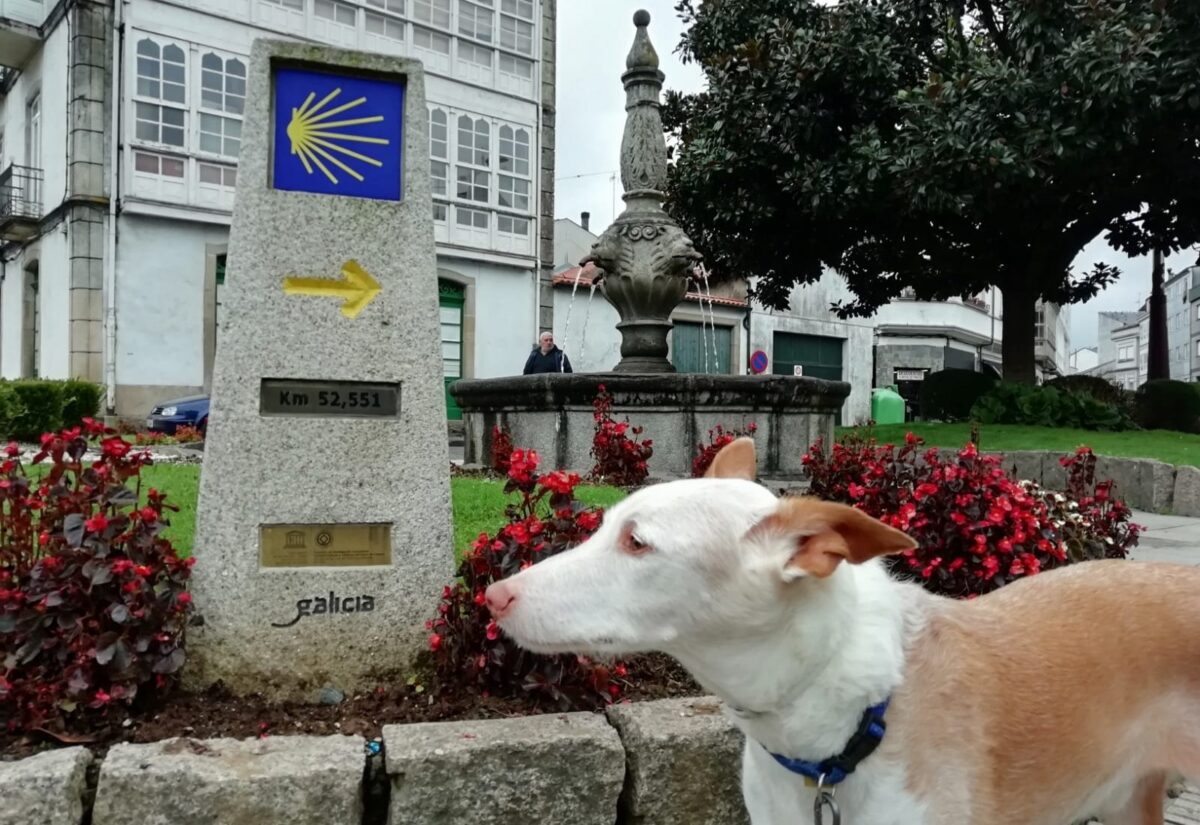
The challenge of doing the Camino in summer without a reservation
Most pilgrims prefer good weather and plenty of company, and therefore choose to do the Camino de Santiago during the high season months. This can create some difficulties when it comes to finding accommodation, as those who risk setting off on the pilgrim adventure without making reservations may encounter problems in this regard.
The same applies to luggage transport and other services that may be needed during the Camino de Santiago. The range of accommodations and services is vast on the Camino de Santiago with a dog, but the number of pilgrims you may encounter in summer is even greater, and it is highly recommended to book everything in advance before embarking on a journey along this ancient route.
For this, Viajes Camino de Santiago is the best solution for doing the Camino de Santiago with your dog. With us, you’ll be guaranteed a unique travel experience, with all the comfort and security of being in the best hands.
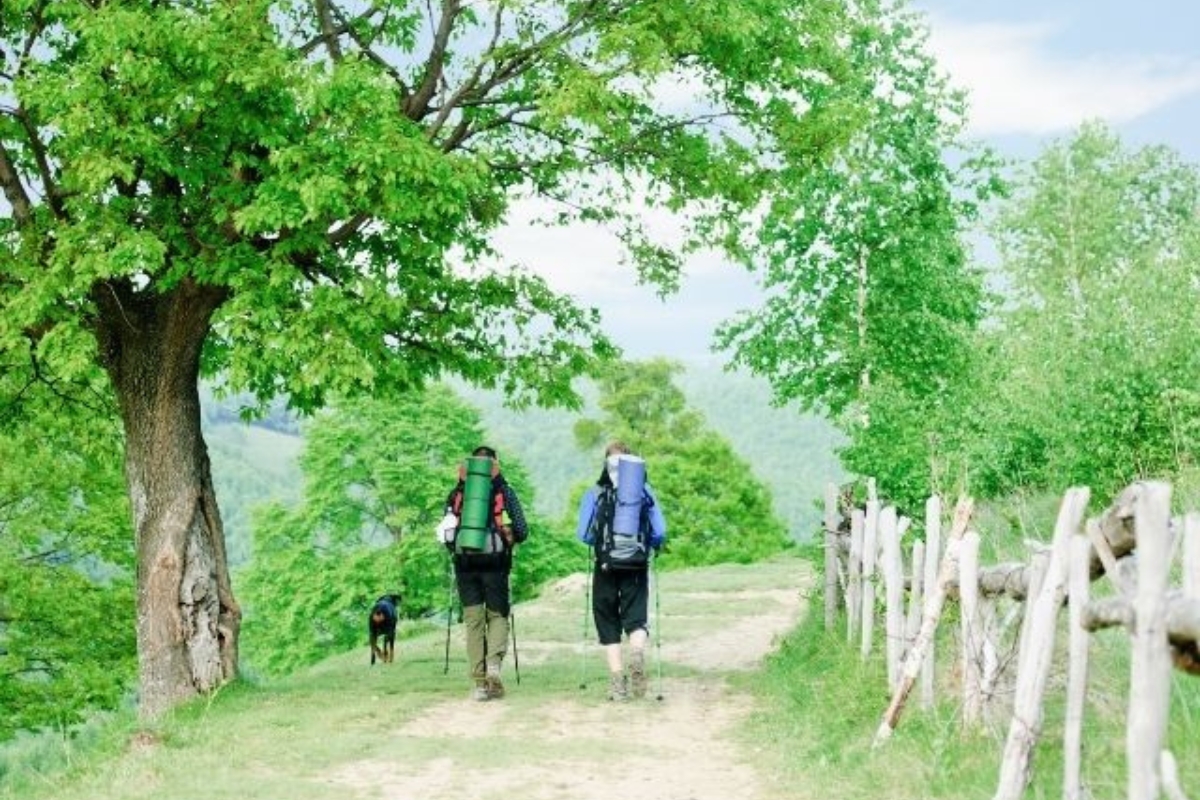
Camino Francés from Sarria with your dog
The Camino de Santiago from Sarria covers approximately 115 km through the south of the provinces of Lugo and A Coruña, in Galicia, offering a varied landscape of green hills, lush forests, fresh rivers, and charming small villages.
Map of the Camino Francés from Sarria
Along this route of the Camino Francés from Sarria, pilgrims pass through small towns such as Sarria and Melide, as well as charming villages like Furelos and Ribadiso. You’ll encounter flowing rivers like the Miño, unique monuments such as the Church of San Nicolás in Portomarín, the ancient Castro de Castromaior, and iconic places like Monte do Gozo.
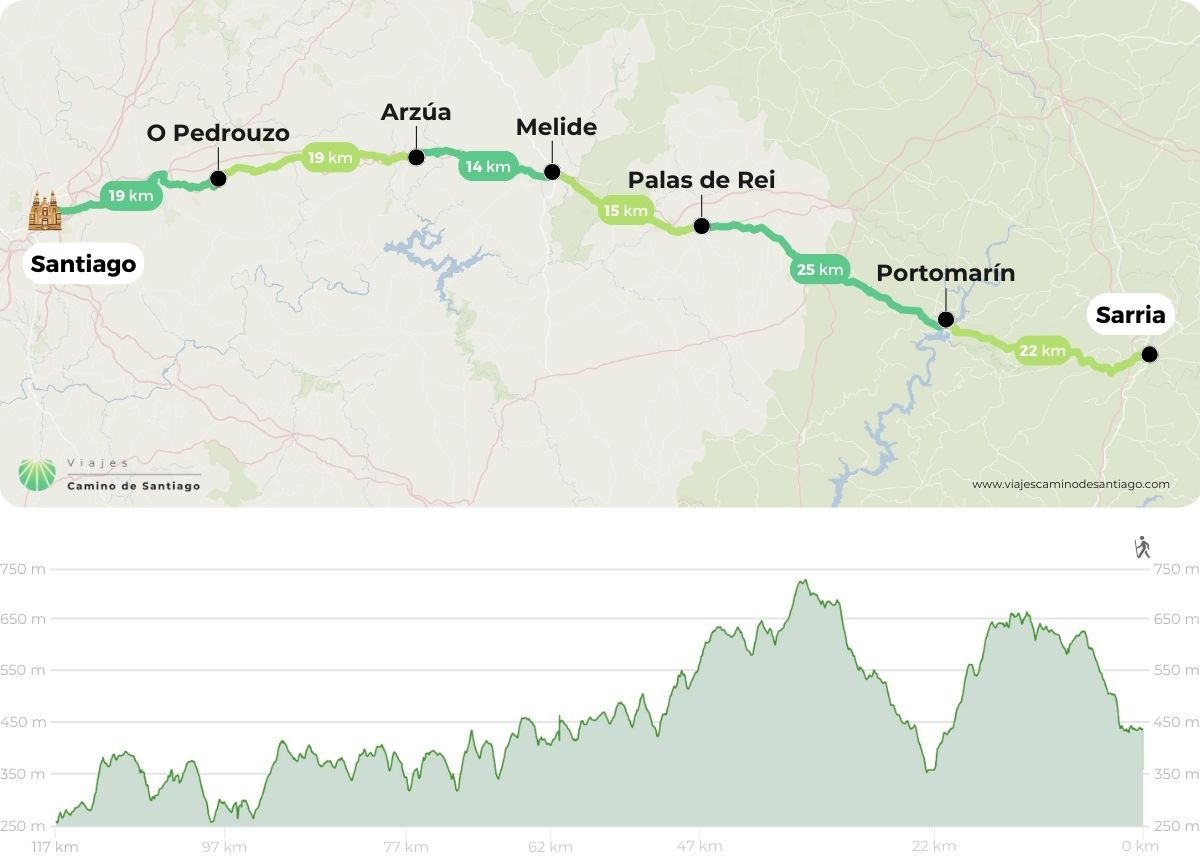
The maximum altitude will be 726 meters above sea level at Ventas de Narón, while the minimum, 254 meters above sea level, will be in Santiago de Compostela. In total, the positive elevation gain will be around 2100 meters, while the negative will be about 2300 meters.
Stages of the Camino de Santiago from Sarria
Most pilgrims who walk the Camino de Santiago from Sarria to Santiago de Compostela divide the route into 6 stages. These stages are distributed as follows:
| STAGE | START | FINISH | KM | DIFFICULTY | TIME |
|---|---|---|---|---|---|
| 1 | Sarria | Portomarín | 22 | Low | 5h.30m. |
| 2 | Portomarín | Palas de Rei | 25 | Medium | 6h. |
| 3 | Palas de Rei | Melide | 15 | Low | 3h.30m. |
| 4 | Melide | Arzúa | 14 | Medium | 3h.30m. |
| 5 | Arzúa | O Pedrouzo | 19 | Low | 5h. |
| 6 | O Pedrouzo | Santiago de Compostela | 19 | Low | 5h. |
If you wish to do it in 5 stages, the option would be to combine stages 3 and 4 from the previous table, walking between Palas de Rei and Arzúa, thus saving a day on the Camino.
Stage 1: Sarria – Portomarín (22 km)
You will begin your journey on the Camino Francés from Sarria, in a first stage of 22 km known for its ease and charm. As you progress, you will cross rivers and lush forests, where small churches like Santiago de Barbadelo and picturesque villages like A Pena, home to the highly photographed milestone marking the 100 km point, will invite you to take a break and enjoy the surroundings. Through the bucolic Galician fields, between crops and herds of cows, you will reach the banks of the Miño River and be welcomed by the charming town of Portomarín, famous for its church-fortress of San Nicolás and its well-kept white houses with slate roofs.
Stage 2: Portomarín – Palas de Rei (25 km)
Today, you will head towards Palas de Rei, a 25 km stage that combines some road sections (don’t worry, they have a shoulder for pilgrims) with forests and meadows, as well as some elevation changes that add a bit of challenge. Along the Camino, you will explore the archaeological site of Castromaior, an excellent example of ancient Galician settlements. Further along, in Ventas de Narón, you will reach the highest point of the entire route and have the opportunity to visit a small but interesting Templar chapel that hides a surprise. Once in Palas de Rei, you can rest as you deserve in a town with plenty of pilgrim atmosphere.
Stage 3: Palas de Rei – Melide (15 km)
Today will be a pleasant walk that will take you through charming villages and ancient medieval bridges, as well as the green Galician meadows. With only 15 kilometers to cover, you’ll have the chance to enjoy a relaxed breakfast before setting off towards Melide. The route features gentle and progressive elevation changes, easy to overcome. Upon reaching Furelos, with its impressive bridge, be sure to visit its small church, as it hides an altar with a very special sculpture. Once in Melide, you can enjoy a peaceful afternoon exploring its historic center and taste the famous pulpo á feira in one of its traditional seafood restaurants.
Stage 4: Melide – Arzúa (14 km)
This stage, although short at 14 km, will require a bit more effort due to the elevation changes you’ll encounter starting at the Church of Santiago de Boente, in the last 8 km of the stage. However, before that, you’ll be rewarded with the beauty of the Galician forests that will surround you, such as when crossing the beautiful Catasol River and its unique bridge. Also, if the weather allows, in Ribadiso de Abaixo, just 3 km from the end of the stage, you can cool off in the river and enjoy the magical surroundings of this charming spot. Finally, in Arzúa, you’ll find all the necessary services to replenish your energy and rest.
Stage 5: Arzúa – O Pedrouzo (19 km)
This penultimate stage will take you to O Pedrouzo, on a peaceful and pleasant 19 km walk across flat and comfortable terrain, always through forests, fields, and villages. Place names like A Calle and Calzada suggest you are in a historically significant passage for pilgrims, and during this stage, you will meet pilgrims from the Primitivo and Norte routes, with whom you will share the final kilometers to Santiago de Compostela. The Hermitage of Santa Irene signals your arrival in O Pedrouzo, where you should not miss visiting the Church of Santa Eulalia de Arca, with its very pilgrim-like interior.
Stage 6: O Pedrouzo – Santiago de Compostela (19 km)
The big day has arrived, the final stage of your Camino! The last 19 km start with trails through thick eucalyptus forests. After the climb at Amenal, you’ll reach the Santiago de Compostela airport and enter the municipal area. Passing San Paio and the Church of Santa Lucía, you will arrive at Lavacolla, where the also highly photographed 10 km milestone is located, and where pilgrims once washed themselves in the river before reaching Santiago. As you reach Monte do Gozo, you will experience a unique emotion as you catch your first glimpse of the majestic towers of the cathedral. This moment will be the perfect prelude to savoring the last kilometers and making your triumphant entrance into the iconic Plaza del Obradoiro.
You did it, you’re in Santiago! Feel proud and happy for completing your Camino de Santiago with your dog.
Useful Links about Sarria
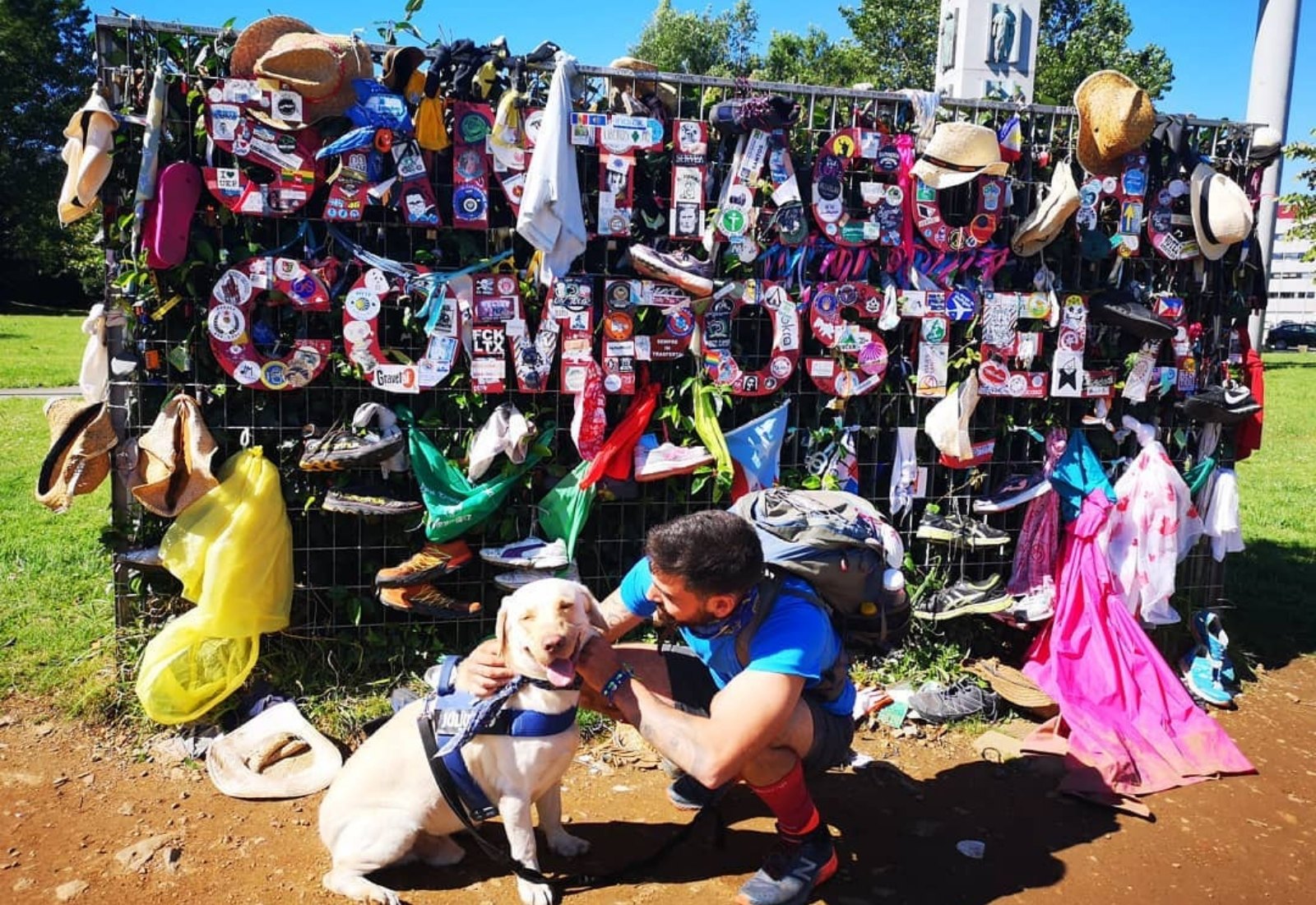
Portuguese Way from Tui with your dog
The Camino de Santiago from Tui covers just over 115 km through the province of Pontevedra and the southern part of A Coruña, in Galicia. With varied landscapes of estuaries, rivers, forests, and vineyards, it passes through villages, towns, and even large cities.
Map of the Portuguese Way from Tui
Along this route of the Portuguese Way from Tui, the pilgrim passes through historic sites such as Mos and Pontesampaio, large cities like Pontevedra, and iconic places of the Jacobean tradition like Padrón. Additionally, notable features include rivers like the Miño, estuaries such as Arousa, the vineyard landscapes, the Barosa waterfalls, and the hot springs of Caldas de Reis.
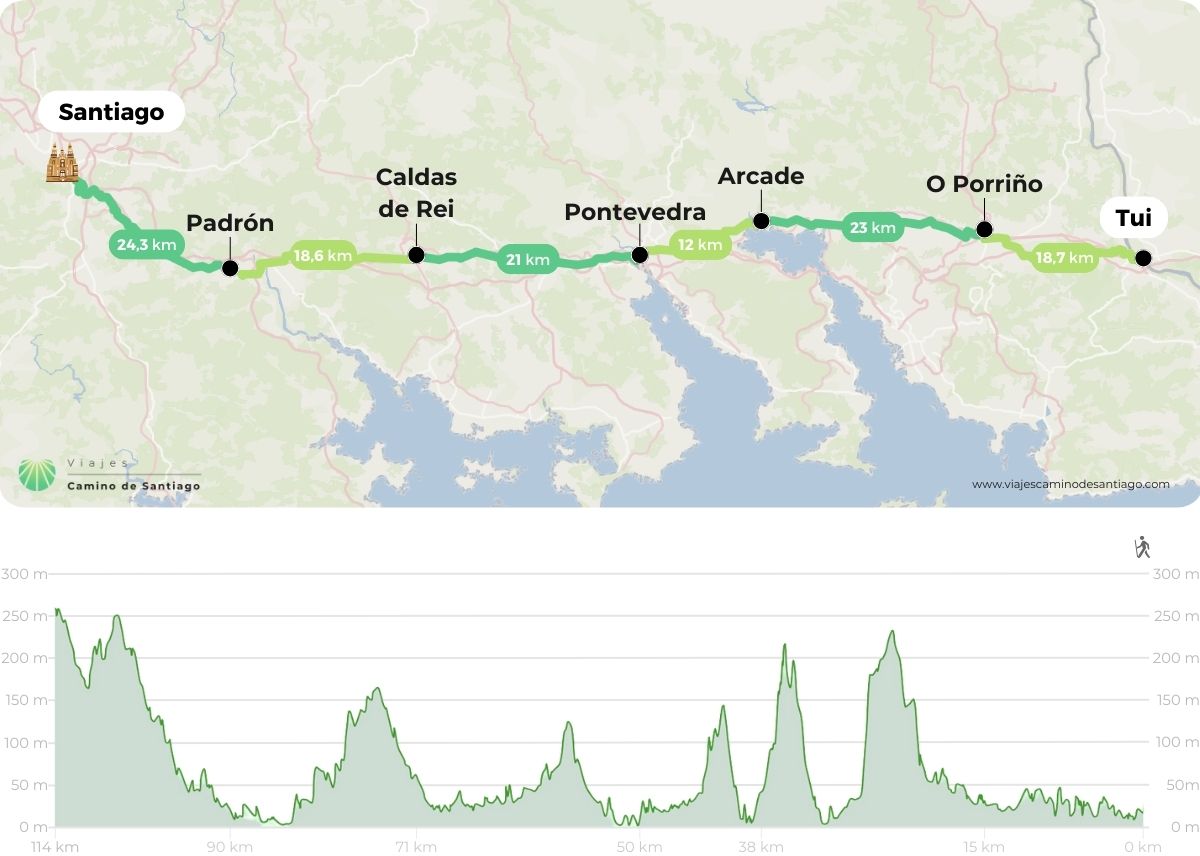
The maximum altitude will be 254 meters above sea level in Santiago de Compostela, while the minimum will be sea level in Pontevedra. In total, the positive elevation gain will be about 1700 meters, while the negative will be around 1500 meters.
Stages of the Camino de Santiago from Tui
Most pilgrims who walk the Camino de Santiago from Tui to Santiago de Compostela divide the route into 6 stages. These stages are distributed as follows:
| STAGE | START | FINISH | KM | DIFFICULTY | TIME |
|---|---|---|---|---|---|
| 1 | Tui | O Porriño | 18,7 | Low | 4h.30m. |
| 2 | O Porriño | Arcade | 23 | Medium | 6h. |
| 3 | Arcade | Pontevedra | 12 | Low | 3h. |
| 4 | Pontevedra | Caldas de Reis | 21 | Low | 5h.30m. |
| 5 | Caldas de Reis | Padrón | 18,6 | Low | 5h. |
| 6 | Padrón | Santiago de Compostela | 24,3 | Medium | 6h. |
If you want to do it in 5 stages, simply split the first 3 stages into 2, walking from Tui to Redondela, and from Redondela to Pontevedra, saving one day of travel.
Stage 1: Tui – O Porriño (18.7 km)
The Portuguese Way from Tui begins with a gentle stage of about 18.7 km, starting from the beautiful historic area of Tui’s old town, with its cathedral as the main attraction. After passing through the tunnel of the Convent of the Encerradas, you will leave the city, walking parallel to the Miño River. A trail of lush vegetation through the natural spaces of the Gándaras de Budiño follows. Before the end of the stage, you can choose to go by road or follow the Louro River, a slightly longer but much more beautiful and shaded route. This will lead you to O Porriño, a town with all the necessary services where you can rest properly.
Stage 2: O Porriño – Arcade (23 km)
Today, you will head towards Arcade, on a 23 km stage with some interesting climbs that will be worth the effort, as it will take you to the historic town of Mos and the chapel of Santiaguiño de Antas. You will be able to admire and walk along the path of the ancient Roman road XIX, and a historic Roman milestone along the route will remind you of this. After descending, you will reach Redondela, and after leaving the town and ascending again, you can enjoy spectacular views of the Vigo Estuary and coastal landscapes that are worthy of being framed. The experience culminates in Arcade, known as the oyster capital, where you can savor this delicacy accompanied by a good wine.
Stage 3: Arcade – Pontevedra (12 km)
Today, the Camino to Pontevedra will be a 12 km walk that will take you across the historic Ponte Sampaio, a key site in the Peninsular War. After a beautiful cobblestone path through forests, you will reach the chapel of Santa Marta, after which you can continue to Pontevedra by road or along the Tomeza River trail. We recommend taking the latter option, a pleasant walk through the meanders of the cool river. Once in Pontevedra, you’ll be treated to a special reward, as you can enjoy one of the most beautiful cities in Galicia, full of heritage such as the Church of the Peregrina and the ruins of Santo Domingo.
Stage 4: Pontevedra – Caldas de Reis (21 km)
Leaving Pontevedra, we begin one of the most beautiful stages of this section, with about 21 km that will take you to Caldas de Reis. You will cross the Alba marshes and admire beautiful manor houses, chapels, and wayside crosses. The landscape starts to be dominated by the vineyards of the D.O. Rías Baixas, and before reaching the end of the stage, between A Seca and Briallos, a detour will take you to the stunning waterfalls of the Barosa River. As always, we recommend taking the Camino at a relaxed pace, and this spot is a must-visit. Once in Caldas de Reis, famous for its thermal waters, today you’ll be rewarded with the chance to enjoy its thermal baths, a blessing for your feet and legs.
Stage 5: Caldas de Reis – Padrón (18.6 km)
Today, you will head to Padrón on another beautiful short stage, about 18.6 km. You will admire lush forest trails and beautiful churches, such as Santa María de Carracedo or San Miguel de Valga. Gradually, you will reach Pontecesures, and after crossing the bridge over the Ulla River, you will approach Padrón. In this town with a strong Jacobean tradition, you must visit the Church of Santiago, linked to the legend of the apostle Saint James, and obtain your Pedronía, another Jacobean certificate. Of course, you should try the Padrón peppers, and if it happens to be a Sunday, you can enjoy the Padrón fair.
Stage 6: Padrón – Santiago de Compostela (24.3 km)
The final stretch to Santiago de Compostela, 24.3 km long, passes by the collegiate church of Iria Flavia, the former seat of Bishop Teodomiro II, who played a key role in the discovery of the Apostle’s tomb. You will also pass the beautiful Church-Shrine of Our Lady of A Escravitude, the Pazo de Faramellos, and the place of Rúa de Francos, all surrounded by lovely forests. After passing Milladoiro, you will have 8 km left to reach Santiago de Compostela, and you will catch your first panoramic view of the cathedral. After passing the ruins of A Rocha Forte castle, you will come to a fork that leads to the Plaza del Obradoiro: to the left, via Santa Marta, or to the right, via Conxo. We recommend the first option, shorter and more direct to your destination.
And you’re in Santiago, where you can celebrate completing this wonderful Camino full of history, nature, and culture!
Useful Links about Tui
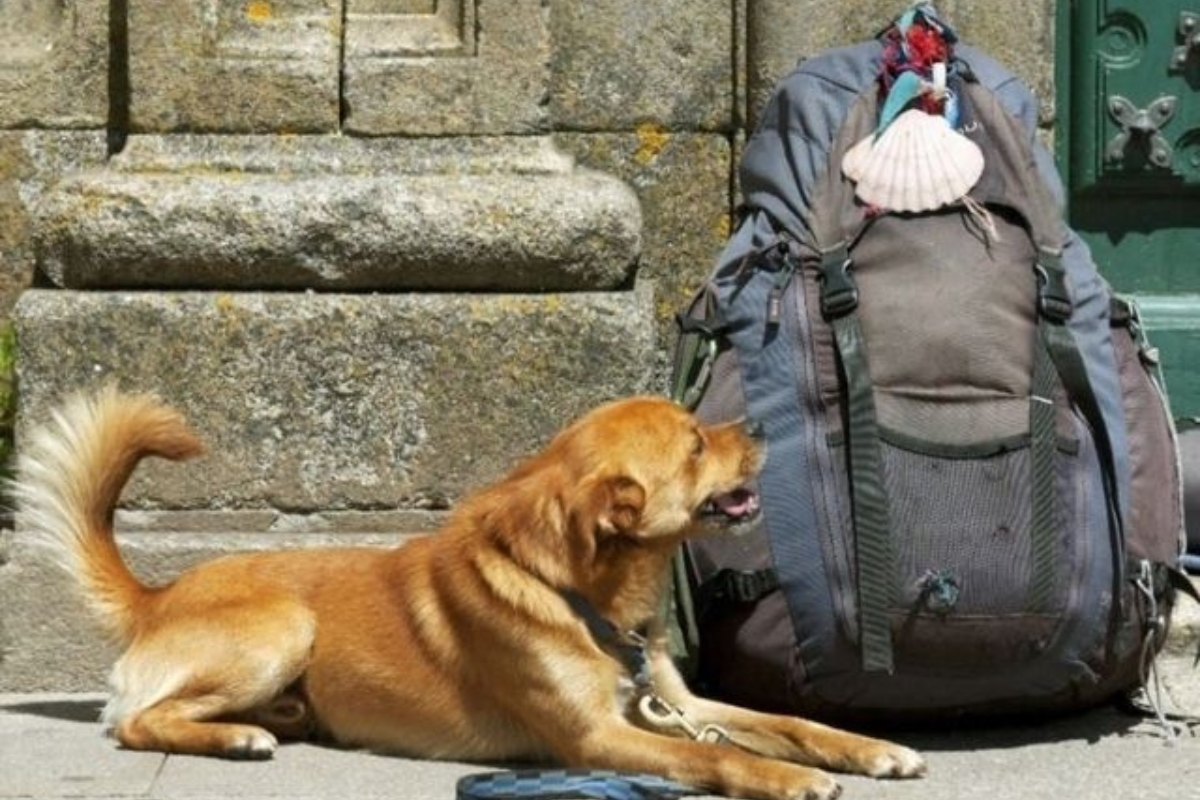
Portuguese Way by the Coast from Vigo with your dog
The Camino de Santiago from Vigo covers approximately 100 km through the southern parts of the provinces of Pontevedra and A Coruña, in Galicia. Parallel to the beautiful Vigo estuary, you will reach Redondela, where the route joins the Portuguese Way from Tui.
Map of the Portuguese Way by the Coast from Vigo
Along this route of the Portuguese Way by the Coast from Vigo, the pilgrim passes through historic sites such as Pontesampaio, large cities like Pontevedra, and iconic places of the Jacobean tradition like Padrón. Additionally, the Vigo, Pontevedra, and Arousa estuaries, the vineyard landscapes, the Barosa waterfalls, and the hot springs of Caldas de Reis stand out.
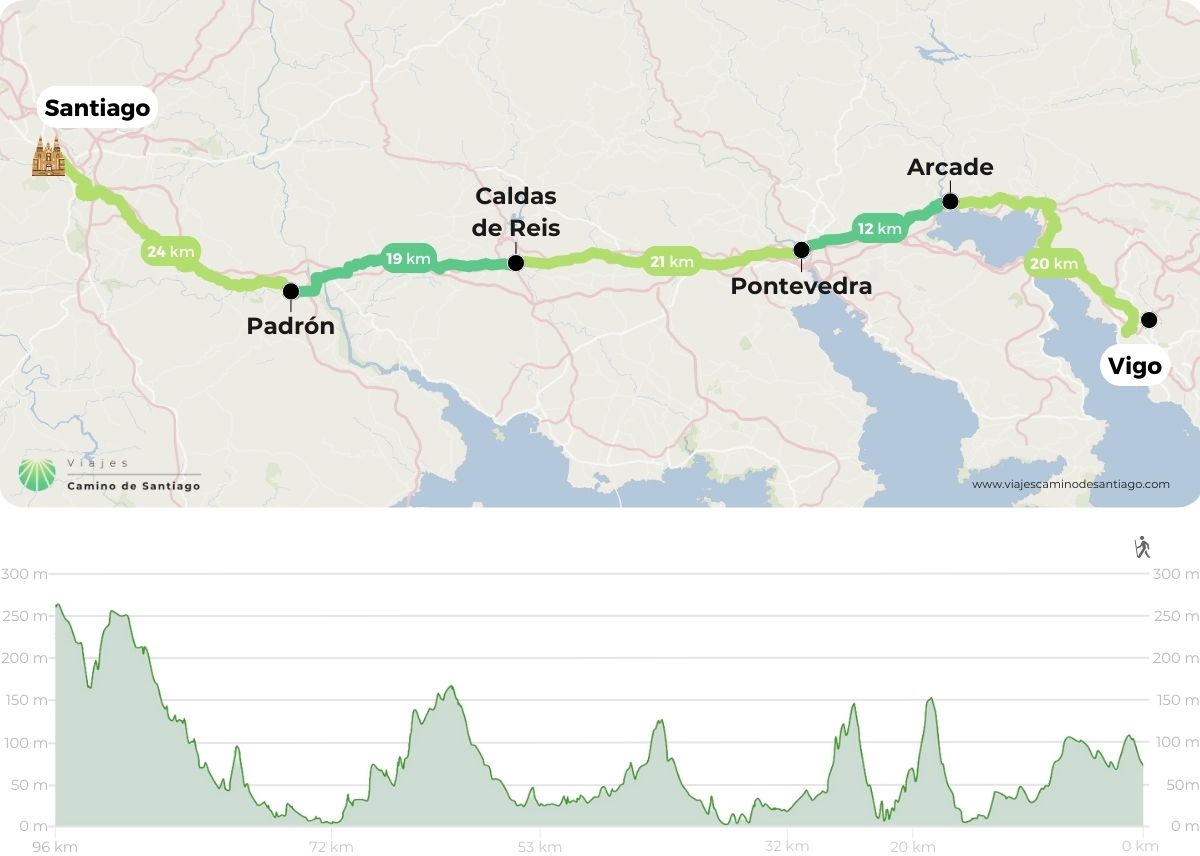
The maximum altitude will be 254 meters above sea level in Santiago de Compostela, while the minimum will be sea level in Vigo or Pontevedra. In total, the positive elevation gain will be around 1500 meters, while the negative will be about 1300 meters.
Stages of the Camino de Santiago from Vigo
Most pilgrims who walk the Camino de Santiago from Vigo to Santiago de Compostela divide the route into 5 stages. These stages are distributed as follows:
| STAGE | START | FINISH | KM | DIFFICULTY | TIME |
|---|---|---|---|---|---|
| 1 | Vigo | Arcade | 23 | Medium | 4h.30m. |
| 2 | Arcade | Pontevedra | 12 | Low | 3h. |
| 3 | Pontevedra | Caldas de Reis | 21 | Low | 5h.30m. |
| 4 | Caldas de Reis | Padrón | 18,6 | Low | 5h. |
| 5 | Padrón | Santiago de Compostela | 24,3 | Medium | 6h. |
As you can see, and we insist, the Portuguese Way by the Coast from Vigo connects with the Portuguese Way from Tui in its first stage, in Redondela, before reaching Arcade.
Stage 1: Vigo – Arcade (23 km)
Leaving Vigo behind, you will continue along a path that runs close to the coast until reaching Redondela. Along the way, you will enjoy spectacular views over the Vigo estuary, the Cíes Islands, the massive Rande suspension bridge, and on the other side of the estuary, the Morrazo Peninsula. But undoubtedly, one of the most fascinating spots will be found in the middle of the estuary: San Simón Island, its inlet, the surrounding wetlands, and the small beaches. Upon reaching the end of the stage, in Arcade, you can savor its famous oysters and enjoy all the necessary services for pilgrims.
Stage 2: Arcade – Pontevedra (12 km)
Today, the Camino to Pontevedra will be a 12 km walk that will take you across the historic Ponte Sampaio, a key site in the Peninsular War. After a beautiful cobblestone path through forests, you will reach the chapel of Santa Marta, after which you can continue to Pontevedra by road or along the Tomeza River trail. We recommend taking the latter option, a pleasant walk through the meanders of the cool river. Once in Pontevedra, you’ll be treated to a special reward, as you can enjoy one of the most beautiful cities in Galicia, full of heritage such as the Church of the Peregrina and the ruins of Santo Domingo.
Stage 3: Pontevedra – Caldas de Reis (21 km)
Leaving Pontevedra, we begin one of the most beautiful stages of this section, with about 21 km that will take you to Caldas de Reis. You will cross the Alba marshes and admire beautiful manor houses, chapels, and wayside crosses. The landscape starts to be dominated by the vineyards of the D.O. Rías Baixas, and before reaching the end of the stage, between A Seca and Briallos, a detour will take you to the stunning waterfalls of the Barosa River. As always, we recommend taking the Camino at a relaxed pace, and this spot is a must-visit. Once in Caldas de Reis, famous for its thermal waters, today you’ll be rewarded with the chance to enjoy its thermal baths, a blessing for your feet and legs.
Stage 4: Caldas de Reis – Padrón (18.6 km)
Today, you will head to Padrón on another beautiful short stage, about 18.6 km. You will admire lush forest trails and beautiful churches, such as Santa María de Carracedo or San Miguel de Valga. Gradually, you will reach Pontecesures, and after crossing the bridge over the Ulla River, you will approach Padrón. In this town with a strong Jacobean tradition, you must visit the Church of Santiago, linked to the legend of the apostle Saint James, and obtain your Pedronía, another Jacobean certificate. Of course, you should try the Padrón peppers, and if it happens to be a Sunday, you can enjoy the Padrón fair.
Stage 5: Padrón – Santiago de Compostela (24.3 km)
The final stretch to Santiago de Compostela, 24.3 km long, passes by the collegiate church of Iria Flavia, the former seat of Bishop Teodomiro II, who played a key role in the discovery of the Apostle’s tomb. You will also pass the beautiful Church-Shrine of Our Lady of A Escravitude, the Pazo de Faramellos, and the place of Rúa de Francos, all surrounded by lovely forests. After passing Milladoiro, you will have 8 km left to reach Santiago de Compostela, and you will catch your first panoramic view of the cathedral. After passing the ruins of A Rocha Forte castle, you will come to a fork that leads to the Plaza del Obradoiro: to the left, via Santa Marta, or to the right, via Conxo. We recommend the first option, shorter and more direct to your destination.
And you’re in Santiago, where you can celebrate completing this wonderful Camino full of history, nature, and culture!
Useful Links about Vigo
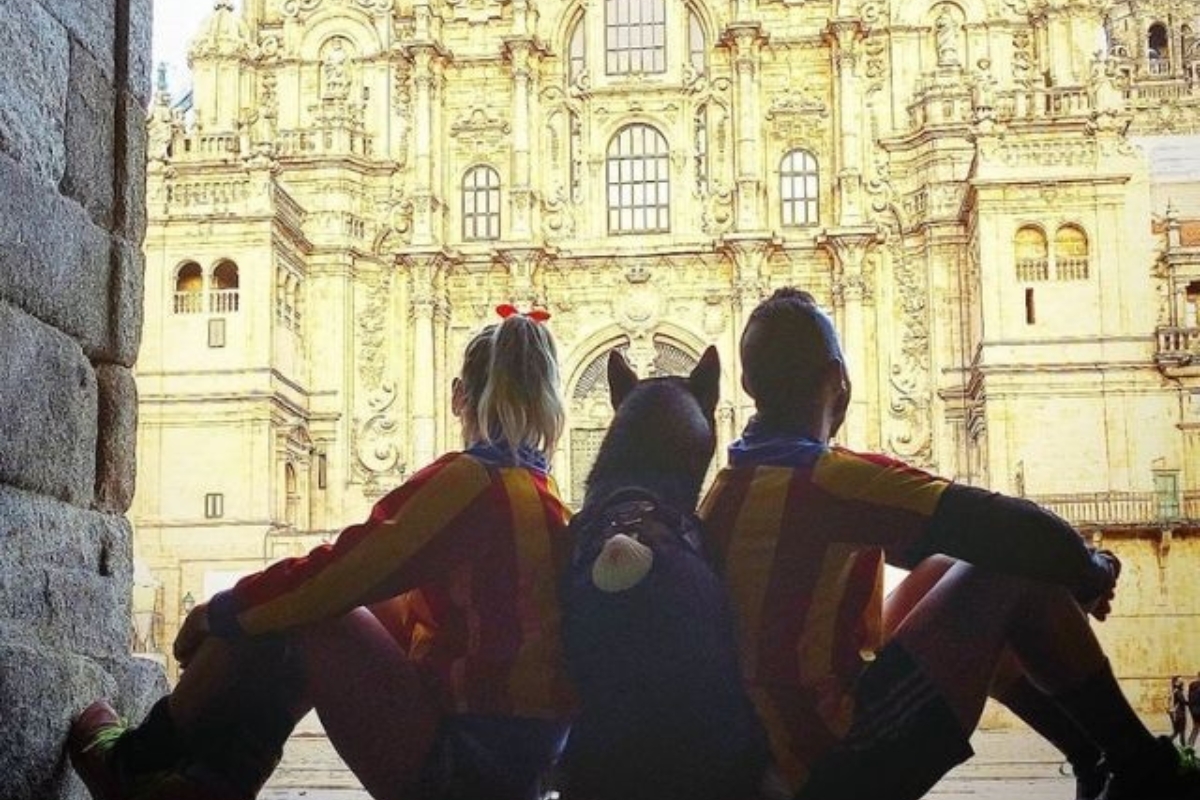
Photos of the Camino de Santiago with a dog
Frequently Asked Questions about the Camino de Santiago with your dog
Well, simply because everything you do in life is cooler when you do it with your dog! ;)
Just like the rest of the pilgrims, it’s necessary to walk the last 100 km to reach Santiago. You’ll need to remember to collect at least 2 stamps per day and then go to the Pilgrim’s Office to collect your Compostela.
It depends; you’ll have to check each time. Although it’s true that the Camino is becoming more dog-friendly, it’s best to inquire on a case-by-case basis.
Yes, but you’ll need to bring your own food and your dog’s own bowl. You’ll also need to bring a water bowl.
Although it’s currently difficult to predict the weather, we recommend avoiding periods of extreme heat and heavy rainfall. Dogs can handle a lot, but it’s true that especially in hot weather, their paws suffer more.
If you don’t have much flexibility in choosing dates, just make sure your dog’s gear for the journey is appropriate: good boots and a good raincoat.
No, only the mandatory insurance and the vaccination record.
There aren’t really any restrictions; dogs can access any section of the Camino without a problem. The only important thing is to remember to leash them in sections where the Camino coincides with roads and to keep them under supervision when they are off-leash. Additionally, we recommend leashing them when encountering loose livestock.
Our experience tells us that the most suitable routes are the French Way from Sarria and the Portuguese Way from Tui. Over the years, we’ve found that along these sections, dogs are welcomed as another pilgrim, treated with care, and you’ll also find a good network of services available for them: dog-friendly accommodations, transportation, veterinarians, etc.
We recommend that you always keep your dog on a leash on roads, in urban areas or in towns where there are likely to be loose animals. In Galicia it is allowed by law that dogs are allowed to run loose on rural roads. Therefore, you can let it enjoy whenever you are in rural areas, forests, fields etc.
If during the Camino de Santiago you have any incident with your pet and it makes it impossible to continue walking, we have a transfer service from any point of the Camino. In addition to the documentation provided upon reservation, you’ll have access to a helpline while on the road for assistance. Don’t hesitate to reach out to us!
Carrying the veterinary card or canine passport is mandatory. Additionally, it’s recommended to attach a tag with your name and phone number to your pet’s collar.
The optimal choice is to either travel by car to the beginning of the route or to park it in Santiago de Compostela. We offer a pet transfer service to any location along the Camino de Santiago. Feel free to reach out to us for assistance!
Typically, each booking includes accommodation for one dog. If you plan to travel with additional pets under the same reservation, please let us in advance.
Doing the Camino de Santiago with your dog is possible! And also an incredible experience to be able to share such a magical trip with our furry friend. Although there are more and more accommodations on the pilgrimage route that allow pets, we always recommend planning in advance and travel with the accommodation booked.
If you are planning to do the Camino de Santiago with your pet, you should know that there is a special credential for dogs that you can get in the Animal Protection Association of the Camino de Santiago (APACA). With it you will be able to prove once you arrive in Santiago that your dog is also a champion.
Some accommodations, despite allowing pets, have an internal policy to ensure that dogs are not left unattended in rooms to prevent any disturbance to other guests, such as barking. Therefore, we recommend that you always check with your assigned accommodation designated accommodation regarding their specific policies and arrangements for pets.
You and your dog will comfortably share the same room for sleeping without any issues.
arrangements for each leg of the journey covers the following services:
- Accommodation arrangements for each leg of the journey
- Luggage transport for both your luggage and your pet’s belongings
- A comprehensive dossier containing information about the various stages of the journey
- Pilgrim’s credential
- Canine credential
- On-the-road helpline for any assistance required during the journey
- Travel insurance coverage for added security and peace of mind
Additionally, you have the option to tailor your trip by including the following optional services:
- Additional nights at the start or end of each stage
- Private transfers from Santiago de Compostela to either the beginning or end of each stage.
You WIL NOT be able to include:
- Breakfast or half-board options. Dining areas are shared with other pilgrims who may not be comfortable with dogs or could have allergies. However, you can inquire about this option at each accommodation and arrange it directly with them. Additionally, we’ll provide you with a guide featuring advice, including places where you can have breakfast, lunch, or dinner with your pet.
Unlike group tours, there won’t be a bus service, guide, or support vehicle provided between stages. However, you’ll have access to a 24-hour hotline where you can reach us in case of any issues or unexpected events.
Yes, of course! It’s important that your dog is accustomed to long walks and hiking in the mountains.
Certainly, for our dog-friendly routes, we do allow pets! Take a look at our link to see the available routes.


